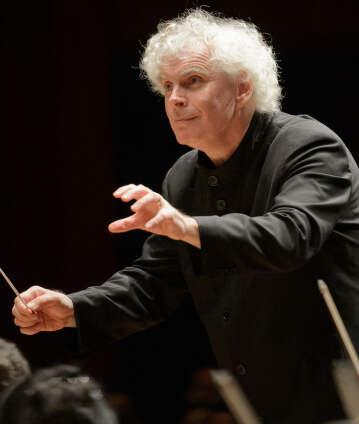Simon Rattle conducts Brahms, Schoenberg, Berg and Webern

Brilliant, but non-sensuous: that is many concertgoers’ opinion about the music of Arnold Schönberg and his pupils Alban Berg and Anton Webern. This concert, in which Simon Rattle presents orchestral pieces by the three composers, shows just how wrong they are: virtuoso music of overwhelming expressiveness. One important inspiration for Schoenberg’s circle was Johannes Brahms, whose sun-drenched Second Symphony ends the concert.
After mulling on the score of his First Symphony for more than twelve years – the piece was launched in Karlsruhe in 1876 – Johannes Brahms’s work on his next contribution to the most important orchestral genre of the 19th century went relatively easily. The composer began drafting his Second Symphony in the summer months of 1877 during a holiday stay in Pörtschach am Wörthersee – in Brahms’s words “virgin territory, with melodies flying around all over, such that one has to be careful not to tread on any”. He was able to complete the work already in October of that year. Although, especially compared to its predecessor, Brahms’s Second Symphony structured in the pastoral key of D major appears more fair than cloudy, the composer informed his publisher one month later with his typical subtle humour that the new work is “so melancholic that you will not be able to bear it. I have not yet written anything quite so sad, so ‘minor’: the score must appear with black borders and in mourning!” The Viennese premiere of the Second Symphony turned into a triumph for Brahms – despite the fact that the composer, in the words of the critic Eduard Hanslick, was in this work at particular pains “to disguise or mute everything which could look like ‘effect.’” In fact, Brahms confronted the gaudy thematic material and orchestral excesses with which his antipodes were at the time causing a stir with contrapuntal sophistication, novel techniques of motivic development and rhythmic structures that were both differentiated and well-proportioned.
56 years after the premiere of the Second Symphony none other than Arnold Schoenberg highlighted how forward-looking these aspects of Brahms’s compositional technique were: in 1933, the founder of twelve-tone music made the surprising assertion that the development of modern music was influenced to no small extent by Brahms. It is a logical consequence that Sir Simon and the Berlin Philharmonic precede their interpretation of Brahms’s Second Symphony with orchestral works by Schoenberg and his students Alban Berg and Anton Webern. Composed in the years between 1909 and 1915, these compositions have in common that they break away from the romantic tradition of large-scale symphonic formal structures, even with their individual titles as (orchestra) pieces. Beyond a doubt, Brahms’s compositional technique designated “developing variation” by Schoenberg is reflected in these works.
© 2016 Berlin Phil Media GmbH
Related interviews
Artists
Our recommendations
- Simon Rattle conducts Mahler’s “Symphony of a Thousand”
- Simon Rattle conducts Dvořák, Turnage and Brahms
- Simon Rattle conducts Mahler’s Sixth Symphony
- “40 Years of the Orchestra Academy” Gala Concert with Simon Rattle
- Europakonzert from Prague with Sir Simon Rattle and Magdalena Kožená
- Paul Whiteman’s greatest hits with Simon Rattle and Max Raabe